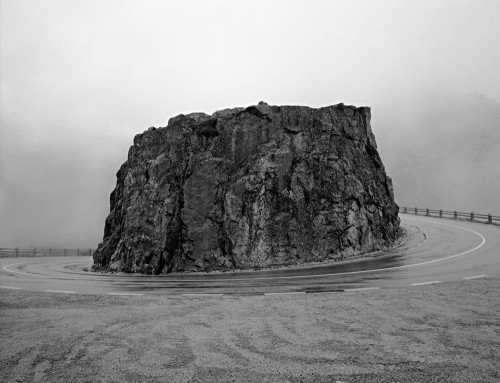
Adrien Missika, photography and media.
“The mother’s silence—whatever reasons motivate it—is an experience that
every child has in a repetitive way, an experience that will be fantasised as the
mother’s refusal to offer the sound object that is a source of pleasure; moreover,
this experience is very often something that the mother does not think that she
has to justify, that she may impose without knowing that she is imposing it.”
Piera Aulagnier
“The incomparable language of the death’s-head: total expressionlessness- the black of
the eye sockets- coupled with the most unbridled expression- the grinning rows of teeth.”
Walter Benjamin
“The knowledge to which the snake seduces, that of good and evil, is nameless. It is vain in the deepest sense… Knowledge of good and evil abandons name; it is a knowledge from outside, the uncreated imitation of the creative word.”
Walter Benjamin
The mechanisms of corporate mass produced narrative is firstly a removal of allegory. For allegory enters narrative at exactly the moment plots are decided and conclusions foreshadowed by explanation. I find that most Hollywood TV series are only interesting up to that exact point. The last episode of most series are consistently the worst and most deadening. For allegory is history embedded in narrative. It is not quite the removal of the symbolic, but it is close. The paradoxical aspect of this, if that is what it is, lies with how the conditions for allegory have eroded, and how audiences seem increasingly blind to them. Now, Benjamin saw a difference between tragedy and Trauerspiel, or mourning play (that which he wrote his doctoral thesis on in Origin of German Tragic Drama). Tragedy is more a process of revelation than it is something pegged to narrative characteristics. But more on tragedy below. For allegory is also melancholy, and contemporary Western culture denies the melancholy as anything affirmative. It is pathologized and considered a state of mind worthy of medication. Benjamin also saw murder in ancient Greek tragedy as part of a complex of actions of sacrifice. He saw later drama treating murder as simply criminality.
But what does this indicate for contemporary culture? Jamieson Webster remarked that the current passion for ignorance (her description) was a part of the fabric of a rejection of psychoanalysis. Which is an interesting observation, I think. Contemporary mass culture is one that treats psychoanalysis as a hobby or parlour trick. An amusement. But then it treats art that way. Today’s mass culture is simultaneously one of constant irrelevant noise.

Reinhard Mucha
“In a comment appended to a dream in Adorno’s Dream Notes, he wrote, “our dreams are linked with each other not just because they are ‘ours’, but because they form a continuum, they belong to a unified world, just as, for example, all of Kafka’s stories inhabit the ‘same world’.” One might see here not just a theory of the Other but the possibility of a unified world that isn’t only simply a delusion or a nightmare. It is certainly a wish, but isn’t it interesting that wishes exist in a continuum that forms a unity in a being that is otherwise described after modernity as rent.”
Jamieson Webster
(Interview with C. Derrik Varn)
The idea of entertainment, then, is very pernicious. And it is pernicious in the exact way that science and positivism have claimed an ideological corral around all discourse, today. The element of the human retreats ever further from the material in the disciplines of the academy. It is also pernicious by virtue of the technology and the rapidity with which all content is passed along. Webster noted in that same interview that the idea of the human scale, or proportion, was crucial to the thinkers (and scientists if you like) of the middle ages. I have said the same thing before, too. With a claim of rationality, or a certain rationality, came a loss of intimacy. Of course at the heart of this there is a contradiction in that the idea of the *individual* is foregrounded so much in popular culture. Everything is individualized, at least formally. And yet, really, the language of contemporary thought is increasingly de-politicized and made abstract. It is generic.
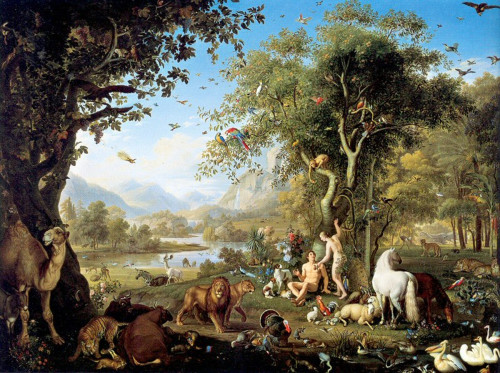
Wenzel Peter (Garden of Eden, late 1700s).
But this abstract generic quality is not empty, of course, it is an abstract of ersatz identities. One is this, but also this, and this, too. All of these attributes are vague and mostly empty. Often one hears people say, “I’m like that….”. It is a kind of ideologically infused narrative astrology column. Now, the etymology of allegory is literally ‘other story’. Joel Fineman has said that the fact that there even is a structure to narrative suggests a desire for allegory. That desire then, in both psychoanalysis and allegory is a structuring principle.
But the abstract and generic is actually what Benjamin called, in another era, *phantasmagoria*. And this is people choosing illusion over their own intimate awareness. Benjamin said over *divine truth*. In the garden, Adam had a job, naming things. He had an intimate and direct relationship with the material world. The knowledge of the snake is the knowledge that removes the subject from the material. Now, Benjamin saw fetishism as a core attribute of how phantasmogoria works. So the fall from paradise is a fall into fetishism and illusion. For Marx, remember, the commodity acquired a fetish property following the logic of capital and exchange value. This led to reification. So, from one direction comes this fetishizing of ‘things’, and from the other a distancing quality born of language itself, but also of the seductions of illusion, and then from yet another direction comes the residual traumas of childhood. Marx saw something almost magical in how commodities changed human relations. The fetish was a metaphor in a sense, but then it became something more. For all magic becomes something more. And it is important to understand that the class subjugation and inequality of advanced capital is the very opposite of magic. It is the removal of all qualities of life and living. It leaches intimacy and tenderness and compassion. And even the left today (and for a while) recoil in horror and affront at the idea of not being highly rational. And yet there is an acute danger with a dependency on rationality at the expense of magic, I think.
There is a relationship between narrative and fetishism, or perhaps more between narrative and Benjamin’s phantasmagoria. For the fall from paradise is a story. And it is an allegory. And it is a story that operates like a dream. But the germane point is that phantasmagoria (as Benjamin has it) is an allegory of itself. It is a metaphor, too, in a sense for a Gramscian vision of superstructure (more below) but it firstly something like a self analysis. Margaret Cohn in an essay on Benjamin, has a great description here…
“Allegory’s etymology implies the possibility of redemption and as
such contrasts with the etymology of the phantasmagoria, which substitutes
ghosts for the allos that signifies allegory’s transcendence. Appearing
as allegory’s demonic Doppelgdnger, the phantasmagoria remains
firmly rooted in the haunted realm of commercial exchange.”

Rio Saito, photography. (Ring road, Cairo).
Now at an earlier point in the 20th century the idea of allegory was reaching a kind of logical cul de sac. Allegory was everywhere, and everywhere was allegorically everywhere else. It permeated critical thinking, and it surfaced in odd ways in everything from the auteur theory of the Cahiers critics to Northrup Frye to Harold Bloom. As mass electronic culture expanded the commodity form eclipsed all of material relations. The fall from paradise was complete. The evil doppelganger of allegory was now a crappy Hollywood film or TV show whose story is the story of its making and whose writers and directors are auteurs of production, of the invisible phantasmagoria that is the imprint of agents and managers and executives and show runners and especially of telecoms and giant studios. Benjamin had already assumed that allegory was dying. It was replaced with souveniers and trinkets, with *novelty*. For Benjamin, allegory was secret and redemptive (or attempted it). The kingdom of things, while phantasmagoria is a precursor to Debords SI ideas on ‘the spectacle’. It is important to note that Marx’s idea of the fetish (commodity relationship) is religious or mystical. Marx meant to emphasize the obscurantist nature of this relation. Phantasmagoria is secular, it is the draining away of the mystical and spiritual, it is the psychology of a denuded world. And it is, as Michael Jennings has it, a concept that links up, or puts in relief aspects of linear time, and importantly, of repetition.
Gyorgy Markus — who is a very astute reader of Benjamin, writes this…
“It belongs to the very essence of commodity production that it envelops everything
encompassed by it with kaleidoscopically changing compulsive
images (Zwangsvorstellungen): things as commodities acquire for the experiencing
subject the character of wish-symbols. A product of labour is a commodity
if its actual utility, its use-value, constitutes only the external shell of
its generic essence: universal exchangeability, exchange value. To live in a
world which appears as the enormous collection of (real or potential) commodities
means to endow objects with significations that have nothing to do
with their prosaic use, with their useful properties, to confer upon them
meanings that, while no longer transcendent but inner-wordly and in fact
fabricated (through display, fashion, advertisement and so on), again become
reified, since they actually repress and hide their own making, their origin in
human labour and construction.”

Peter Fritz
*Phantasmargoria*, like commodities, is not a reduced or diluted form of rationality, but a promise that is immediately broken. All those shiny trinkets are really just cheap junk. A remnant of a dream. Markus notes that commodities hide their origin in human labor, and hence this disenchantment that promotes itself as enchantment, has it in its best interests to erase memory. Nothing makes such a good purchaser of souvenirs as the amnesiac.
“Allegorical signification is thus a form of interpretation sensitive to the ineluctable otherness repressed in conventional signification.”
Steve Leddin
Benjamin saw one effect of Enlightenment thought in the split between knowledge and experience. The mass culture of entertainment, for example, Marvel and DC comics, is non allegorical because it is ahistorical, but it is not non-ideological. The vigilante and crime fighter is identified with for his or her supremacy while paying lip service to noble intentions that are meant to sympathize with the victims. It is always set in individual terms, however. The Joker is not part of a particular movement, only a isolated criminal. Batman and Superman are individuals with superior powers, and represent a vague idea of stability and normalcy. The narrative of these films and TV shows erases history and normalizes the idea of a world without history. Modernity itself becomes ahistorical. This is the sublimated mythology of individuals who *experience* the world and form ideas about it. Period. As if born anew each day.
Benjamin seemed to see *phantasmagoria* as both a deceptive ideological tool that aligns with Capitalism and as a potential tension that can come to yield insight into the dream.

Jose Sanchez Cotan
Benjamin criticized the Enlightenment for a lack of analysis regards experience. The end result of which was, for Benjamin, a tendency to privilege the eternal over the historical. The long term effects inflated an idea of objectivity that was based on perception as it occurred in the abstract. At the other pole is the new age romanticism of transcendent purity of perception. In a sense the comic book super hero is always either an accident (the origin myth) or a visitor from other worlds. He or she exists in this vacuous artificial world in which only superior abilities and power can overcome the obstacles of the actual world. An actual world that is never represented anyway. Benjamin saw, in his idea of historical materialism, a radicalizing of interpretation; one which recognized the dialectical relationships of past and present and the conditional qualities of all experience. And this is directly related to the desire for and structuring effects of allegory. The narrative that rises to the allegorical is one in which indeed, on one level, everything IS allegorical. Except of course, it’s not. But finding the correct interrogation of and questioning of why one thing is or isn’t is the purpose of art. There is a close resemblance to dreamwork here.
A certain kind of scientism and historicism naturally fed into a demand for, or belief in, eternal truths. But not just eternal truths, but a narrowly defined eternal. A sort of kitsch eternal.
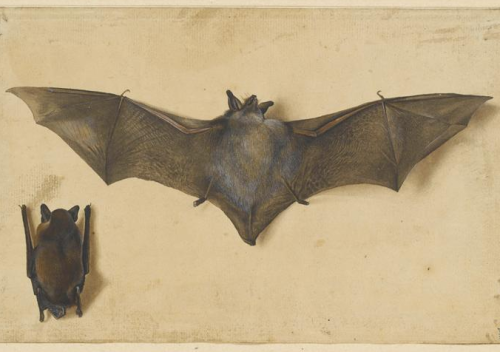
Albrecht Durer
“What distinguishes [historical] images from the “essences” of
phenomenology is their historical index… These images are to be thought of
entirely apart from the categories of the “human sciences,” from so-called
habitus, from style, and the like. For the historical index of the images not
only says that they belong to a particular time; it says, above all, that they
attain to legibility only at a particular time.”
Walter Benjamin
This leads back to psychoanalysis and just how disruptive was the advent of psychoanalysis which saw that memory was both historical (collective and individual) and fragmentary. The past was nothing one could fix as absolute but one in which the absolute was sedimented. Both psychoanalysis and historical materialism focus on the effect the past has on the present, and on the over-determination of meaning in experience. As Steve Leddin puts it, in a very good essay on Benjamin, what historical materialism allowed for was a disclosure of otherness. In one way, this is also what psychoanalysis did. One aspect of the affinity between allegory and psychoanalysis is in the treatment of *origins*. Or perhaps it is better to say *lost origins*. Or forgotten ones. Obsessional neurosis is keenly allegorical. Origins are Oedipal.

Anne Marie Prolx, photography.
“..that passage in the thoroughly interpreted dream which has to be left obscure … a tangle of dream-thoughts which cannot be unravelled and which moreover adds nothing to our knowledge of the content of the dream. This is the dream’s navel, the spot where it reaches down into the unknown. The dream-thoughts to which we are led by interpretation cannot from the nature of things have any definite endings; they are bound to branch out in every direction into the intricate network of our world of thought. It is at some point where this meshwork is particularly close that the dream-wish grows up. like a mushroom out of its mycelium.”
Freud (Interpretation of Dreams)
Fineman points out that it is Lacan’s great insight to recognize that … “If psychoanalysis has discovered anything, it is precisely this loss of the self to the self which we vaguely refer to when we speak of the function of the unconscious”.
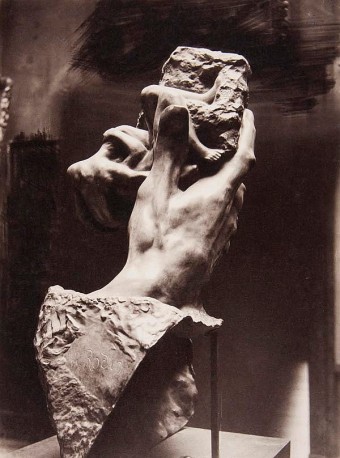
Pierre Choumoff, photography. (study of Rodin’s sculptures).
This existential vertigo that accompanies our inner life is one that positivism and contemporary scientism seeks to deny. The self must be absolute and verifiable. And narrative, today, operates from codes of verifiability, or ersatz character, who rarely question the interior fragility the subject lives with constantly. In other words we narrate ourselves to ourselves and we recognize or sense the gap between the story and the *reality*. Except the reality is a remembered story or dream, in a sense. Tear off the mask and there is another mask underneath and one underneath that ad infinitum. Our representing ourselves is always a narration, a story.
Tom Waits amusing remark that “The world is a hellish place, and bad writing is destroying the quality of our suffering,” comes to mind. But this is the place of allegory. Our story is always the other’s story. The stranger’s story. And the mimetic process is one in which as we re-narrate and re-present ourselves, AS selves, there is a quality of terror accompanying this. The expressionless black skull that Benjamin noted. In his essay on Baudelaire, Benjamin writes… “The key figure of the early allegory is the corpse. The key figure of the later allegory is the “souvenir”. The “souvenir” is the schema of the transformation of the commodity into a collector’s object…The heroic tenor of the Baudelairean inspiration shows itself in this, that with him memory recedes in favour of remembrances.”
Perception adjusted to industrialization, as it had to Enlightenment logic and rationality, and now it is adjusting to the post industrial screen world of the 21st century. But this historical perceptual adjustment always inscribes the suffering of new mass violence, administered and planned. Efficient and organized.
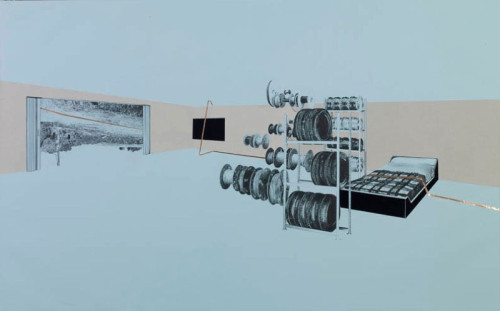
Tatiana Trouve
The mass apparatus absorbs all image and narrative. The defacto branding affect renders oppositional, or disruptive art, into its opposite. Except it cannot quite do this completely. And it is in the small interstices of failed absorption that works of autonomy exist. Except sometimes, if not often, these few works are only partially free of this neutralizing effect. This is a autonomy of failure. So what becomes crucial is the audience’s interrogation of the work. And this interrogation is itself under duress. And this duress takes one back exactly to allegory and desire. And in a sense this is the one area where Heidegger has some relevance. The ‘standing reserve’, that backdrop that is really an order of order, a structural appearance that serves to fill in the sense of splitting between self and story of self. And really, this is also Derrida in a sense. But to return to allegory here. The narrating of self, the making sense of oneself by recourse to a private story is something Freud sensed and half-articulated, but which Lacan took a step further. And even if one fails to follow the signifier signified endless extrapolations of Lacan, the germane point is that our being born into language is something we never escape. But if this culture of literacy and text can no longer produce either in any meaningful autonomous way, then the inner lives of people will compulsively repeat the same failures and same terrors. For there is no grammar (in social relations) that can describe any of this. So, as Fineman observes, whether it is Lacan or Derrida or even Girard, the structuralist and post structuralist are always caught in a paradox of being ahead of time an allegory of themselves. I suspect Adorno would have noted this, and really Peter Dews did note this, by seeing in Adorno a prioritizing of questioning bourgeois identity and its incorporating of identities’ role as a part of social domination. And maybe this is the allegory of social domination itself that is at work.

Ryan Trecartin, installation.
I am reminded of Kleist here, and a comment he made in a letter to his wife; “the neccessity of playing a role and an inner aversion to doing so, make every social situation burdensome to me…”.
John B. Lyon, wrote of Benjamin…“Benjamin describes allegory less as a genre and more as a mode of perceiving and experiencing the world.”
But the apparatus of domination is there to reduce experience and does that by narrowing perception into junk scientistic jargon (the neuroscientists are big on this). Dews goes onto quote Jochen Horsich (who has exactly none of his work available in English, sadly) who writes that Adorno saw a secret history of subjectivity inscribed with suffering, or a history of suffering inscribed with concepts of identity. He saw a coercive compulsory *identity*, fraught with contradiction and loss, forced on the subject — beginning in childhood and reinforced or given shape by language. And this construct of identity is seen as eternal and above and before experience. And this was one of the roles that art and by extension culture played in human communities. Religion was aesthetic, and ritual was a processural aesthetic activity. The rote performance of ritual was a way to perform the process of psychic formation (and societal) and thereby relieve it of its onerous weight. But the emptying of ritual’s metaphysics left only the inherent tendency to compulsive repetition. Death instinct for Freud. Removing aesthetics, which is a judgement of difference, exposes or heightens a slumbering violence.
“In the cinema, a society that has lost its gestures tries at once to reclaim what it has lost and to record its loss.”
Agamben

Jesse Mockrin
The entire thrust of identity thinking is coercive. But this is only because of a focus or privileging of positivist (Enlightenment) thinking where the specific definition must be seen as inviolate. The removal of the non-complete renders a sort of fiction laid across all contemporary experience. And who is to argue when digital computer technology so amazingly and quickly provides responses and answers to our input. We get answers where there were no questions. Adorno saw the compulsive aspects of identity inseparable from the fleeting moments of non-identity, or identity is compulsive because the subject recognizes the contradictions inherent in it. But identity has a material aspect, and this is where space and place enter. As Edward Casey has it….“the uniformity of space and the equability of time have replaced, or more exactly displaced, the priority of place”. The influence of positivist thinking, of that hyper rational scientism, cannot be over emphasized, I don’t think. It is so deeply ingrained today that every breath one takes is infused with an interior reflection that is calculating and compilating. It passes unnoticed, in a sense. One is calculating probabilities way before spontaneous emotions are experienced. The Star Trek character Spock was so popular because he was the latent ideal man. Much as years later the Terminator was. The autistic savant is very appealing to a populace crippled with compulsive neurosis and denial of its experience of non-identity. So today the experience of space, the organizing of distances and locations are purely abstract (or nearly so) and drained of their history. And more importantly, perhaps, drained of social and political history.
There is a constant manufacturing of narrative by corporate media. The election season is an increasingly empty event but it must be infused with basic almost childish narratives. And the public response, because of the felt distance between reality and this manufactured narrative, is one of exaggerated emotion. The response to Trump, or Sanders or HRC, both positive and negative is overwrought and hysterical. For elements of this narrative have existed in all national elections in the U.S. for the past thirty years. Only now, in a culture of such narcissistic compulsive neurosis the reactions are taking on qualities of desperation. This is an increasingly hollow spectacle. And the compensatory hysteria lives in the corridors of power as well. The violence and sadism of the ruling classes today is unparalleled in modern times.

Dougie Wallace, photography. (Shoppers at Harrods).
“Benjamin’s central aesthetic principle remains the Romantic insight that the meaning of an object unfolds only in and as a historical process. The meaning of a work of art cannot be fixed once and for all by mere assifuilation to a pre-given model. Indeed, in Benjamin’s view, works of art are more interesting and provocative the more imperfect their fit into any supposed genre.”
Graham Gilloch
Allegory is a part of a process of deciphering the deeper relationships in artworks, the hidden made visible or legible. And through such a concept the historical echos are reintroduced. No rules or measurement can do this. Benjamin read Hamlet as a mourning play (Trauerspiel) and less as a tragedy. Previously unrelated meanings are fused into a new reading Shakespeare’s work. Jamieson Webster and Simon Critchley write of Benjamin on Hamlet….
“… the the listlessness and dullness of heart of the saturnine prince are manifestations of the state of acedia, a kind of depressive position that was common to ascetics and solitaries in the medieval world. As he is wont, Benjamin quotes a thirteenth- century source, where acedia is linked to tracheit, in modern German Trägheit, “slowness” or “inertia.” It is the precise word that Freud uses to describe the experience of the death drive.”
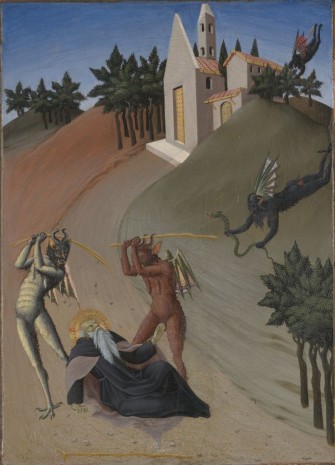
Sano di Pietro, 1435.
So, in what way is Batman not Hamlet? The answer, whatever one comes up with (from a long list) will have to do with latent historical meanings. And these meanings are revealed in a grammar of extraordinary density. The split, that coercive aspect of language, is made visible, is given speech, through a new arranging — an objective interpretation from an objective expression. For as Benjamin says, phenomena are not contained IN ideas. The ideas are correlates of the expression. In Marvell comic book characters the objective is generic, and the general ideas, themselves banal, cannot be mined for allegory. They do not even allegorize their own banality. They might be symbols of something, but that is one dimensional. Kitsch entertainments, melodrama, the sentimental bathos of most U.S. drama, erases history — and it does this by creating symbols that are linear and static. All interpretation is, in one way, allegorical. But not all allegory allows for interpretation. Batman is a symbol of vigilante justice, of phallic power and cruelty, but his story is not an allegory. For Batman to be allegory it must be other than literal. The super hero is literally what he labeled — a super hero. Of what does his heroism consist? He murders to maintain truth justice and the American way. Of course the super hero is an allegory of a society blind to allegory. So maybe the question is more about the quality of allegory. Any super hero, if he existed in real life, would be enormously creepy. Even putting aside the costumes, Super Heroes are humorless anal sadistic creeps, guys who you might suspect of exposing themselves at the bus station.
“Allegory is extravagant, an expenditure of surplus value; it is always in excess.”
Craig Owens
And Adorno ironically (I think) said that in psychoanalysis the truth is in exaggeration. Allegory, Walter Herbert Sokel suggested, has a moral dimension. This accesses Benjamin’s complaint about Goethe and his symbolism — where the symbol is only operative in a world of perfect concordance. Whereas in the ‘fallen’ world, the particularity of the symbol is nullified. For allegory is expressing that disunity between identity and language. The fallen aspect is expressed as something close to *doubt*. And here the audience or reader or viewer must be open to these moments of non-identity. The super hero (or most any protagonist in U.S. television) is denying any disunity of self. And perhaps this is the core distinction between kitsch or commodity art, and allegorical work. And it is Kafka, probably, who exemplifies the Benjaminean notion of allegory. For Kafka is both revealing and hiding. He is also an allegory of writing as revelation. And of course the jingoism of U.S. culture today imprints narratives that are literally vetted by the Pentagon. So the absence of doubt is linked up with this nativist neo fascism that is resurgent. The militarism and lurid patriotism of mass culture today is certainly an element in the suffocating of deep meaning, and really in the stoppage of interpretation generally. For the authoritarian sensibility is one that has no inner life at all. No time for frivolous intellectual pastimes. The brutal cop, the sadistic soldiers, that entire construction of domination is premised on repetition as it exists as an action of the death instinct. The class conflict, the inequality, racial and gendered bigotry; this is the de-facto model for identification.
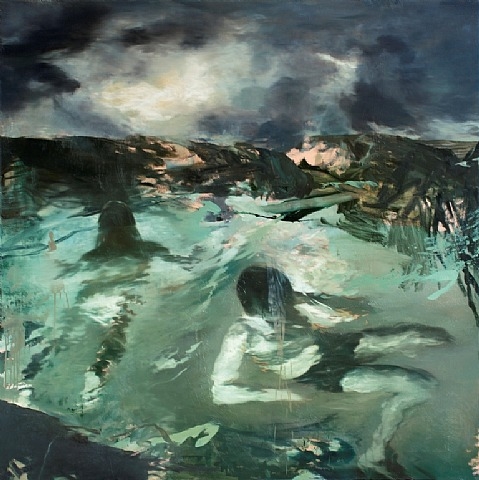
Lars Elling
Benjamin’s study of ‘Mourning plays’ made two crucial points for both his later thought, and for post post modernism.
“It is one thing to incarnate a form; it is quite a different thing to give
it its characteristic expression. Whereas the former is the business of
the poet elect, the latter is often done incomparably more distinctly
in the laborious efforts of minor writers … [T]he form itself becomes
evident precisely in the lean body of the inferior work, as its skeleton
so to speak.”
The characteristic expression is tied into questions of genre, and in the case of Trauerspeil, Benjamin less sees failed tragedy than he sees a characteristic expression of a particularly grotesque world. In that sense one might see Black Mask crime fiction as a kind of 20th century American Trauerspeil. And there is a decisive difference between Jim Thompson and Michael Bay or Zach Snyder. The Black Mask writers transcribed the downfall of a culture, a society spinning aimlessly toward further despair. Snyder, as just one example, cannot help but attempt to allegorize himself. He depicts an ironic trope that is only self referential narcissism at its core. And that is what Hollywood does, today. If John Ford or Val Lewton made allegorical films that were also self referential, the Cohn Brothers or Snyder or Affleck today make self referential kitsch that ironizes their own still born allegorical aspirations. Hollywood movies are today entirely about the making of Hollywood movies.
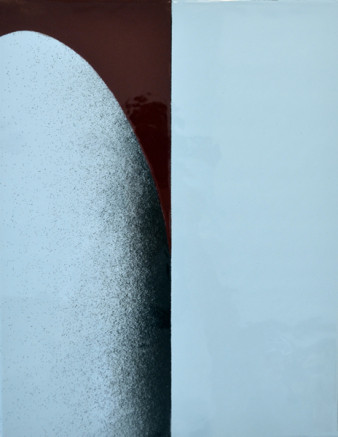
Ulrike Muller
The dominant class today has stolen the redemptive nature of art and culture. Much as they and the U.S. military and domestic police have stolen the sense of hope from communities. The popular form of execution today, speaking spiritually, is suffocation. The society has already suffocated only they don’t know it. They try to make breathing shapes with their mouths, but the mouth is frozen. The tyrannical and violent nature of novelty and souvenier, of tourism and voyeurism has removed allegorical redemption from the menu.

Taiyo Onorato and Nico Krebs photography.
“…the economic conditions under which a society exists come to expression in the superstructure, just as with someone sleeping, an overfilled stomach,
although it may causally ‘determine’ the contents of the dream, finds in those contents not its copied reflection but rather its expression…”
Walter Benjamin
The non-stop nature of entertainment today also robs the character of silence from the culture. When Piera Auglanier writes of the unsuspected violence of a mother’s with-held but anticipated voice, there is an echo collectively in a dialectical twist. Commodity silence is not silent. Hannah Proctor wrote….“During the interwar years, mass-produced commodities marketed to a new kind of female producer-consumer proliferated—new perfumes with chemical bases that bore no resemblance to the fragrance of flowers, sleek rayon stockings, gaudy lipstick—synthetic masks of womanliness appropriate to an emerging synthetic reality. Life coated in a layer of death. Even at her most “feminine” she [he, it, they] is inorganic.” Now Benjamin wrote of women coercively given the mask of the masculine, brought into men’s jobs AS surrogate men. But today both genders are masked with technological coloring. Benjamin saw machines aligned with death. The mastering of nature, or conquest of nature, the subjugating of the natural world, is the hallmark of ideas like ‘progress’. And again this is true for right and left. The front edges of the resurgent fascism one sees today, and which is emerging aesthetically in ways that are utterly obvious. Mastery is also always masochism. Regression.
And when Althusser saw science, in a sense, manufacturing problems it could then seem to solve, that seems correct too.

Unknown photographer. 1953. Haber Co. fire victim.
Society is economic firstly. And secondly it is cultural. But the story of our guilt and aggression (one out of the other) is an allegory of our interpretation of this story. Guilt is an introjected and internalized narrative of the life of the super ego. For everything is always finally a story. Benjamin’s divine truth is not about facts. Nothing is verifiable. There are no eye witnesses. The story is the tension of Eros and Death. And our erotic life is an economic story, too. And its a story that allegorizes itself as well. As Paul Ricoeur says, there is everything we can describe without using it and everything we cant describe without using it. Meaning, the *death instinct*.
The knowledge that tempted Adam was nothing he could hear. It was illegible and violent but also violently silent. There is an unfinished story here in which the ability to know *which* silence you’re not hearing becomes a crucial topic.
Tom Waits is right. Only its much worse than that. For once the ability to see and hear the allegorical is lost, my guess is that it can’t again be found. And that is probably an allegory, too.

Cain v. Abel
Esau v. Jacob
Batman v. Superman
Haven’t, won’t see it, but guessing there’s something, however unresolved, yet, there.
This is another fine piece, comforting, confirming, opening.
Divine truth is unnameable, surely, the way, in a lower setting, the true name of the full context of our lives can only be “Unknown”. We live always surrounded, exteriorally and, more disconcertingly, interiorally, by that never ultimately knowable. It should be sort of ironically “familiar” you’d think, and for some of us it is – like a recurrent not quite nightmare where the self is repeatedly threatened with dissolution. Yes, it’s familiar, but what the hell is it.
Magic for me exists right at the furthest edge of the boundary/threshold between the known and the, let’s call it the secular unknown. The Clarkian epigram so many use to do exactly what you point to, leach magic of its vital otherness and deliver its essence into the hands of some future more accomplished rationality. “Magic is just technology we don’t understand yet” or however he said it. Religion is so debased now it requires apology to use the word, but I believe there was a time both magic and religion went in front of us toward that never-knowable both secular and divine unknown. While rationality stayed behind and took care of practical matters.
The use of allegorical form without the poetic breath it needs to live, and more importantly, give life, results in didactic horseshit like that Batman thing with the ticking timebomb from a while ago. Criminal travesty of suborned myth.
For me it’s the heart, the orientation and the fullness of the authorial heart, that makes stories work. That has nothing at all to do with predicted or desired effect on a projected audience.. The glamorous propaganda, the spells of idiocy, the hearts behind that kind of flatulent noise are inverse, filled with emptiness. The only possible retreat from the divine, from truth, is into the self, which must be hollowed out to receive itself.